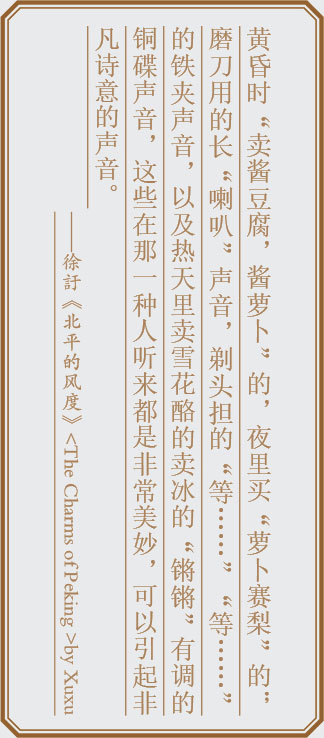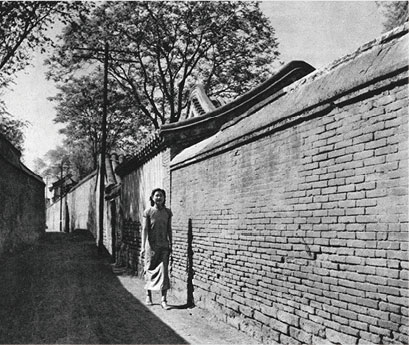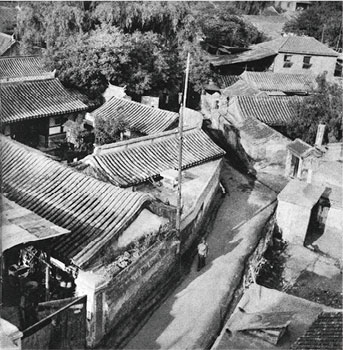胡同和四合院,是北京民居的筋骨、血脉和细胞,充满了地地道道的北京味儿。长长的胡同两旁,整齐地排列着古槐。早晨是“初日照高林”,傍晚是“绿树街边合”,垂檐覆地、蔽日参天。胡同两侧的四合院内,又是另一番天地,静谧的院落,绿荫匝地,清凉沁人。夏日里,石榴花开了,鱼缸里鱼影浮动,鸟笼中鸟儿欢唱,主人在爬满藤萝的天棚下纳凉,闲适惬意。冬日里,大雪纷飞,全家人在屋中围炉夜话,欢饮达旦,温馨和美。
The lanes and quadrangles were known as the bones, blood and cells dwelling in Beijing, which were characteristics of Beijing styles. Along the two sides of long extending lanes, ancient sophora japonicas were planted in order. In the morning "The sunshine shined over the prosperous street", while in the evening," the green street forests would block the shining sun". The leafy branches touch the round, the trees grew straight toward the sky and cover the sunshine. It was another fantastic scene in the quadrangle along the lanes, the court yard was peaceful and quiet, covered by green shadow, fairly cool and comfortable. In summer, pomegranate flowers were blossoming. The fish were swimming in the fishbowls. The birds were singing in the cages. The owners of the quadrangles were enjoying the cool weather under ceiling covered by Wisteria villosa, fairly relaxed and comfortable. In winter, there were heavy snow falls. The whole family were sitting around stove and carrying out a joyful chatting, in the happy and harmony atmosphere.

胡同,源于蒙古语。元人呼街巷为胡同,后即为北方街巷的通称。北京的胡同形成于元朝,明、清以后又不断发展。北京胡同的命名方法可谓是五花八门。有用衙署、官方机构命名的,比如府学胡同、贡院胡同;有用水井命名的,比如高井胡同、沙井胡同;有用市场命名的,比如驴市胡同、菜厂胡同;有用居民姓名命名的,比如贾三胡同、任四胡同;有用特殊标志命名的,比如堂子胡同、铁狮子胡同……等等。据统计,民国时期北京地区大概有街巷胡同3200余条,然而随着城市规划建设的需要,胡同的数量在不断减少,越来越多的胡同在人们的视野中消失,逐渐成为历史的记忆。
The word Lane, was originated from Mongolian language, it was called as Hutung in Yuan Dynasty. Later on, it became a general term for Northern lanes. Lanes in Beijing were formed in Yuan Dynasty and were under constant development in Ming and Qing dynasties. There were various terms for lanes in Beijing. Some were named with local government agencies, such as Fuxue Lane, Gongyuan Lane. Some were named with wells, such as Gaojing Lane, Shajing Lane. Some were named after markets, including Donkey Market Lane, Vegetable Market lane. Some were named after the name of residents, such as Jiasan Lane, Rensi Lane. Still some were named with special symbols, including Tangzi Lane, Teishizi lane and so on. According to the record, there were nearly 3200 lanes in Beijing during the period of the Republic of China. However, based on the requirement of municipal construction, the numbers of lanes were gradually reduced down. More and more lanes disappeared from people’s sight and gradually faded into the history.

